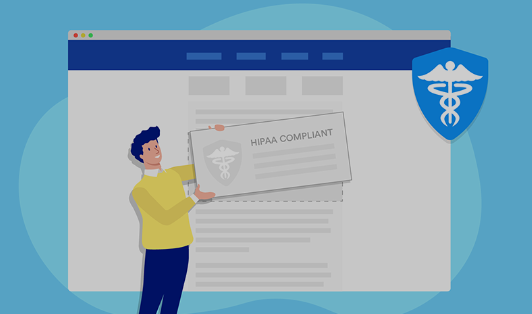If you operate a website that handles Protected Health Information (PHI), it’s crucial to ensure it meets the requirements of the Health Insurance Portability and Accountability Act (HIPAA). This U.S. law sets national standards to protect sensitive patient information from being disclosed without consent or knowledge. Non-compliance can lead to severe penalties, so it’s essential to understand the key features your website needs to be HIPAA compliant.
Here’s a comprehensive HIPAA-compliant website guide to help you ensure your website adheres to HIPAA regulations.
1. Secure Data Transmission
HIPAA compliance requires that any data transmitted electronically is protected to prevent unauthorized access. Here’s how to ensure secure data transmission on your website:
- SSL/TLS Encryption: Implement Secure Sockets Layer (SSL) or Transport Layer Security (TLS) to encrypt data transmitted between your website and users. This protects PHI from being intercepted by third parties.
- Encrypted Email Communication: If you send emails containing PHI, use a secure email service that encrypts messages in transit.
- Secure File Transfers: Ensure any file transfers involving PHI are encrypted and use secure protocols such as SFTP (Secure File Transfer Protocol).
By implementing these security measures, you can protect PHI during transmission.
Know more: A Guide To WooCommerce SSL and HTTPS Setup
2. Access Controls and User Authentication
HIPAA requires strict access controls to ensure that only authorized individuals can access PHI. Consider the following features for your website:
- User Authentication: Implement secure user authentication, such as multi-factor authentication (MFA), to ensure that only authorized users can access sensitive information.
- Role-Based Access Control: Use role-based access control (RBAC) to grant different levels of access based on user roles. This ensures that users only have access to the information they need.
- Password Security: Enforce strong password policies, including minimum length, complexity, and regular password changes.
These access controls help prevent unauthorized access to PHI on your website.
Read: WordPress Data Privacy Measures
3. Data Storage and Backup
HIPAA requires that PHI is stored securely and that backups are properly protected. Here’s what you need to ensure compliant data storage and backup:
- Secure Data Storage: Store PHI in a secure environment, such as an encrypted database or a HIPAA-compliant cloud storage service.
- Data Backup and Disaster Recovery: Implement regular data backups. Also, ensure safe data encryption and storage. Develop a disaster recovery plan to protect data in case of system failure or data loss.
- Data Retention and Disposal: Follow HIPAA guidelines for data retention and ensure that PHI is properly disposed when no longer needed.
Secure data storage and backup are critical for maintaining HIPAA compliance.
4. Audit Trails and Monitoring
HIPAA requires that covered entities maintain audit trails to track access to PHI and monitor for unauthorized activity. Here’s how to implement audit trails and monitoring on your website:
- Logging and Audit Trails: Enable logging to record user activity on your website. Track access to PHI, user logins, and other critical actions.
- Monitoring for Security Breaches: Implement monitoring tools to detect and respond to security breaches. This may include intrusion detection systems (IDS) or security information and event management (SIEM) tools.
- Regular Security Audits: Conduct regular security audits to ensure compliance with HIPAA and identify potential vulnerabilities.
Audit trails and monitoring help you maintain accountability and detect unauthorized access to PHI.
5. Privacy Policy and User Consent
HIPAA requires that covered entities provide information about their privacy practices and obtain user consent when handling PHI. Here’s what you need for your website:
- Privacy Policy: Create a clear and comprehensive privacy policy that explains how your website handles and protect PHI and the rights of users regarding their information.
- User Consent: Obtain user consent before collecting, using, or disclosing PHI. This may include obtaining electronic signatures or providing consent forms.
- HIPAA-Compliant Forms: If your website uses forms to collect PHI, ensure they are HIPAA compliant and provide secure transmission and storage.
Providing a clear privacy policy and obtaining user consent are essential for HIPAA compliance.
Also read: WordPress Website Accessibility and Compliance
6. Business Associate Agreements (BAAs)
If you work with third-party vendors or business associates who have access to PHI, HIPAA requires that you have Business Associate Agreements (BAAs) in place. Here’s what you need to consider:
- Identify Business Associates: Determine which third-party vendors or associates handle PHI on your behalf. This may include cloud service providers, email service providers, or contractors.
- Execute Business Associate Agreements: Ensure that you have executed BAAs with each business associate. These agreements define the responsibilities of the business associate in handling and protecting PHI.
- Monitor Business Associate Compliance: Ensure that your business associates comply with HIPAA and the terms of the BAA.
BAAs are crucial for maintaining compliance when working with third-party vendors.
Know more: Common Website Security Mistakes To Avoid
Conclusion
Ensuring your website is HIPAA compliant is essential if you handle Protected Health Information (PHI). By implementing secure data transmission, access controls, secure data storage, audit trails, privacy policies, and business associate agreements, you can meet HIPAA requirements and protect sensitive patient information.
Compliance is not only a legal obligation but also essential for maintaining the trust of your clients and patients. Consider seeking legal counsel or working with HIPAA compliance experts to ensure your website meets all necessary standards.

